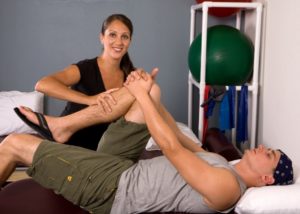You’re done sitting on the sidelines watching everyone else do what they enjoy. You’re ready to get back to you, so you’re finally going to have a total knee replacement. You’ve made the decision, let us help you make your next move.

Having surgery is stressful. A successful outcome and minimal hiccups require a lot of planning and preparation. As they say, you don’t know what you don’t know. So, take some time to write down any questions or concerns and discuss them with your surgeon at your next appointment.
A body and mind that is under stress will not heal as quickly.
Avoid a longer and more painful recovery time by asking the right questions and preparing yourself as much as possible before having surgery.
Hospitalization Questions Answered
How long will the surgery take?
Typically, a total knee replacement takes between one and three hours to complete. Once completed, the surgeon will speak with family or friends to update them on your status.

You’ll probably stay in a recovery room for a couple of hours after the surgery for observation before being taken to your actual room. Once in your room, you’ll be hooked up to an IV and monitors that keep track of your vital signs. A urinary catheter might be required for a day or two after surgery.
How long will I be in the hospital after my total knee replacement?
Typically hospitalized most patients used to stay for two to three days after their surgery. However, with changes in insurance most people are staying only one night in the hospital now. This allows your body time to recover from the anesthesia and initial surgical pain but get home to to the comfort of your own house sooner.
Prehab and Rehab - Ways to Put a Rush on Recovery
What is Prehab?
Prehab refers to physical therapy exercises you do before your total knee replacement. These exercises strengthen and maintain muscle mass, extension and range of motion.
A stronger leg will provide better support with less pain after surgery.
What is Rehab?
Rehab refers to physical therapy exercises that you do after your total knee replacement. These exercises support effective, speedy, and complete recovery.
Make sure you monitor your pain and discomfort levels during rehabilitation exercises. It’s normal to have some pain and discomfort, but it should not be unbearable. If you’re experiencing excessive pain, discontinue certain exercises until you consult with your physical therapist.

Maintain(or Start Living) a Healthy Lifestyle
Heart conditioning
In addition to doing your physical therapy exercises, keep your heart strong by doing cardio exercises before and after surgery. Cardio keeps your blood circulating and can help prevent blood clots.
Proper Nutrition
Eating foods that are high in important vitamins and nutrients is essential to keeping your body operating at its fullest. Eating healthy provides your body with the tools it needs to recover quickly.
Stop Smoking
It’s always hard to stop smoking, but now is the time. Smoking before and after surgery can slow recovery and puts you at higher risk for complications.
Some surgeons won’t do surgery on current smokers
Smoking cigarettes lowers the amount of oxygen carried by the blood. This lack of oxygen causes complications in healing and can increase your recovery time. Many surgeons will not operate on someone who smokes until they have quit for a certain amount of time.
FAQs - Frequently Asked Questions about Recovering from a Total Knee Replacement
How long do I have to wait before taking a shower after my total knee replacement?
 You can shower about three to four days after surgery. Just avoid soaking the incision site. We recommend wrapping your knee to protect it from the shower. Even if you have a large dressing such as an Aquacel, it’s important to not soak. The edges of the steri-strips covering your incision will start to curl around two weeks after your surgery. When that happens, it’s time to remove them.
You can shower about three to four days after surgery. Just avoid soaking the incision site. We recommend wrapping your knee to protect it from the shower. Even if you have a large dressing such as an Aquacel, it’s important to not soak. The edges of the steri-strips covering your incision will start to curl around two weeks after your surgery. When that happens, it’s time to remove them.
How long before I can fully submerge my knee in a pool or hot tub?
Once the incision is fully healed, you can get back to your regular aquatic activities. This takes around four to eight weeks for most people.
Watch our for internal stitches that work their way out a few weeks later. These can create an opening for bacteria to get in the body.
When can I begin physical therapy? How many weeks will I need to go?
Physical therapy begins while you’re in the hospital, often times the same day of surgery. You’ll continue for at least three to six weeks after you go home. You’ll probably visit your physical therapist twice a week until they sign off. They’ll also give you exercises to do multiple times a day at home.
You must have an exercise routine that you perform multiple times a day.
Gaining knee range of motion and strength is critical in the early stages of recovery.
When can I return to work after a knee replacement?
It depends on the type of work that you do.
If you have an office job or one that doesn’t require a lot of physical labor, you should be able to return in about a month. For jobs that require more physical labor, you probably need to wait at least three months before returning to full duty.
Typically, patients don’t have difficulty performing their job. It’s the increased activity and time at a desk or standing that causes more swelling, pain, and stiffness instead of focusing on recover at home.
How long will I be on narcotic pain medication after my total knee replacement?
Most people are prescribed medication for 6-12 weeks post-surgery. Only take these for as long as your pain level requires. Stop taking these as soon you don’t need to, even if your prescription hasn’t ended.
Narcotic pain medication is extremely addictive and can wreak havoc on your digestive system. Many types have negative health effects, including extreme constipation and other uncomfortable issues.

Take your pain medication as recommended. If you feel like you’re becoming too dependent on it, talk to your doctor about switching to a non-narcotic pain reliever.
Here are some helpful tips to get off of narcotic pain medication faster.
Can I get my narcotic pain medication refilled after hours?
Since narcotic pain management medication is a controlled substance, you can’t get these prescriptions filled after regular hours. Make sure you’re fully stocked on all of your medications before you run out.
How long will my knee replacement last?
A total knee replacement is said to last between 18 -25 years years. The main determining factor is how well you take care of yourself.
Eating properly, exercising regularly, and keeping excessive weight off of your joints will all increase the lifespan of your knee.
What is the best age to have a total knee replacement?
There is no ‘right’ age to have a total knee replacement. If you need one, get it! Having said that, a majority of joint replacement surgeries are done on people that are between 60-80 years old.
Studies show that more and more people are having joint replacement surgeries at younger ages than in the past. This has increased the number of revision surgeries. To avoid revision surgery, some doctors recommend waiting as long as you can to have surgery. Just don’t wait too long if your quality of life has diminished.

When can I resume sexual activity after a total knee replacement?
There is no exact answer to this. If you think you can do it; then have fun. Be careful, though and take into considerations range of motion limits and pain with weight bearing. Don’t get too rambunctious and end up back on the surgery table. It might be slightly embarrassing when the surgeon asks you what happened!
What to Expect After a Total Knee Replacement
Dual Knee Replacement - Pros and Cons
Whether or not you have both knees replaced at the same time depends on your situation.
Pros of Dual Knee Replacement
The great thing about having both knees done at the same time is that you only have to deal with being hospitalized one time and can get the recovery over all at once.
- You may get back to normal activities faster
- only one round of anesthesia
- You’re only off work for one 3 month perioe
Cons of Dual Knee Replacement
The two main downfalls of having both knees replaced at the same time is you have a longer hospital stay and you will need help! Having both legs operated on makes it a little more difficult to maneuver around and do what needs to be done.
- Range of motion takes longer to get often
- You are in therapy more hours
- You have to do twice the exercises at home
- Walking for the first 2-3 weeks is a struggle
Tips for Dual Knee Replacement
Be sure to line up full-time home care for the beginning of your recovery process. In many cases, individuals having a dual knee replacement will stay in a rehabilitation facility for the first few weeks until they can get around on their own.
Note: If you have chronic heart or lung conditions most surgeons will not perform a dual replacement due to the risk of complication while being under anesthesia for such a long time.
Still have questions?
The more knowledge you have about your impending total knee replacement, the calmer you’ll feel going into it. If you still have questions about preparing for the surgery, what happens during the surgery, or recovery, follow up with your doctor.
Sources:
(https://www.nhs.uk/conditions/knee-replacement/what-happens/#:~:text=In%20a%20total%20knee%20replacement,knee%20to%20expose%20your%20kneecap.), (https://medlineplus.gov/ency/patientinstructions/000370.htm#:~:text=You%20will%20stay%20in%20the,your%20anesthesia%20and%20the%20surgery.),
(https://www.webmd.com/osteoarthritis/new-knee-rehab-and-pt),
(http://www.kocortho.com/files/4114/0359/0016/dr-nadaud-faq-tkr.pdf )
Other Great Rehab Related Articles
GLP Weight Loss and Back Health: Effective Strategies and Insights
How to Stay Active After Cervical Fractures: Expert Tips and Advice
Dealing with Painful Stairs After Ankle Replacement Surgery
Walking After a Total Ankle Replacement: Tips for a Successful Recovery
Exercises While Non-Weight Bearing After Ankle Replacement: Elevation, AROM, Leg Raises, and More
Ankle Pain with Stairs: Causes and Home Treatment Options
Disclaimer: The information provided in this post is for educational purposes only. This is not a substitute for a medical appointment. Please refer to your physician before starting any exercise program.







Comments are closed.